|
ARTEMISA
 This is a fertile area that is eminently industrial and agricultural, well known for its red rust coloured earth. This town treasures a beautiful history, since in 1953 many young men accompanied Fidel Castro on the assault on the Moncada Garrison (Cuartel Moncada), in Santiago de Cuba. It is a good idea to visit the solemn mausoleum built in honour of the region’s sons, who gave their lives in the struggles for independence.
Also located in Artemisa are the ruins of the famous coffee plantation La Angerona, a National Monument due to its cultural and historic values.
This is a fertile area that is eminently industrial and agricultural, well known for its red rust coloured earth. This town treasures a beautiful history, since in 1953 many young men accompanied Fidel Castro on the assault on the Moncada Garrison (Cuartel Moncada), in Santiago de Cuba. It is a good idea to visit the solemn mausoleum built in honour of the region’s sons, who gave their lives in the struggles for independence.
Also located in Artemisa are the ruins of the famous coffee plantation La Angerona, a National Monument due to its cultural and historic values.
For more information:
www.cuba-lahabana.com
|
|
|
BEJUCAL BRASS BANDS (CHARANGAS DE BEJUCAL)
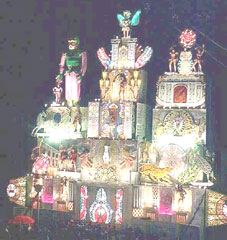 The deeply rooted traditions of the town closest to the capital’s international airport José Martí, come alive during the last days of the year. Then the “charangueros”, divided into two bands, establish a friendly competition carrying out the most varied activities atop their carriages. The final show takes place in the old church plaza and starts very early from the headquarters of each band, where many town people meet in order to follow their favourite carriages from where they were built. The parade through the streets becomes a prelude of the “charangas” show, while fire works, laughter, screams and the strong conga music from each band are heard, announcing the beginning of a great night.
The deeply rooted traditions of the town closest to the capital’s international airport José Martí, come alive during the last days of the year. Then the “charangueros”, divided into two bands, establish a friendly competition carrying out the most varied activities atop their carriages. The final show takes place in the old church plaza and starts very early from the headquarters of each band, where many town people meet in order to follow their favourite carriages from where they were built. The parade through the streets becomes a prelude of the “charangas” show, while fire works, laughter, screams and the strong conga music from each band are heard, announcing the beginning of a great night.
For more information:
www.cubanculture.com
,
www.cuba-lahabana.com
|
|
|
BIRTH HOUSE OF CARLOS BALIÑO
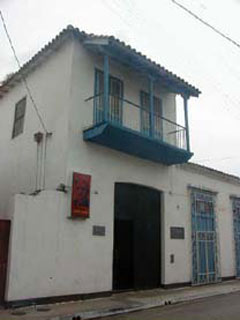 The home of one of the founders of the first Communist Party of Cuba, has been turned into a museum and is located in the municipality of Guanajay, in the westward section of the province of La Habana.
Carlos Baliño was born on February 13th of 1848, and together with José Martí, he created the Cuban Revolutionary Party.
The building, which has resisted the years, dates from the first half of the XIX century, and is located at number 1205 Luz Caballero St., between Agramonte Ave. and 21 de Octubre Ave. The house is made up of a vestibule, a large living room, a garden, a room with a balcony overlooking the street, which is reached by climbing up a wooden staircase in the shape of a seashell.
This historical building has been declared a National Monument.
The home of one of the founders of the first Communist Party of Cuba, has been turned into a museum and is located in the municipality of Guanajay, in the westward section of the province of La Habana.
Carlos Baliño was born on February 13th of 1848, and together with José Martí, he created the Cuban Revolutionary Party.
The building, which has resisted the years, dates from the first half of the XIX century, and is located at number 1205 Luz Caballero St., between Agramonte Ave. and 21 de Octubre Ave. The house is made up of a vestibule, a large living room, a garden, a room with a balcony overlooking the street, which is reached by climbing up a wooden staircase in the shape of a seashell.
This historical building has been declared a National Monument.
For more information:
www.cuba-heroes.com
,
www.cuba-josemarti.com
,
www.cuba-museums.com
,
www.cubaphotobank.com
|
|
|
COLONIAL SUGAR MILL “LA ALEJANDRÍA”
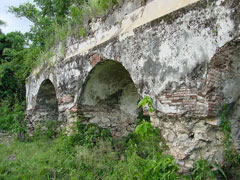 The ruins of the colonial sugar mill of La Alejandría are found to the south of the province of La Habana, in the municipality of Güines, less than three kilometres by the road that leads to the beach of El Rosario.
The place was declared a National Monument on December 31st of 1981 and it includes the remains of the aqueduct, the machinery and the house of the ancient sugar mill of La Alejandría.
These constructions date from 1790 and are an exceptional part of the technological variants of the use of water as a source of energy in the country.
La Alejandría is part of the cultural identity of the town of Güines and has been a source of inspiration for poets, writers, poetry improvisers, historians and artists, among many others.
The ruins of the colonial sugar mill of La Alejandría are found to the south of the province of La Habana, in the municipality of Güines, less than three kilometres by the road that leads to the beach of El Rosario.
The place was declared a National Monument on December 31st of 1981 and it includes the remains of the aqueduct, the machinery and the house of the ancient sugar mill of La Alejandría.
These constructions date from 1790 and are an exceptional part of the technological variants of the use of water as a source of energy in the country.
La Alejandría is part of the cultural identity of the town of Güines and has been a source of inspiration for poets, writers, poetry improvisers, historians and artists, among many others.
For more information:
www.cuba-culturaltours.com
,
www.cuba-history.com
,
www.cuban-culture.com
,
www.cubaphotobank.com
|
|
|
EL SALADO BEACH
Located only 25 kilometres from the capital is a beach protected by the coral reefs and which is a favourite among scuba divers.
The Blue Reef Diving Centre offers beginners night courses, that allow visitors to discover the mysteries of the deep in the moonlight.
As part of the attractions and quite near the hotel complex is an official track for practicing carting, equipped with stands and all. Every year, in these facilities, the stages of the national championship are carried out, from March to December.
For more information:
www.cuba-lahabana.com
|
|
|
HAVANA
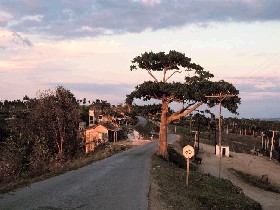 It originated as a province in 1975 with a surface area of 5 731 square kilometres and more than 700 000 inhabitants.
Among its main tourist attractions are the well-known Jaruco Stairs (Escaleras de Jaruco), located in the municipality of the same name, a unique landscape product of the same topography, where the existence of rocky outcroppings and caverns make it the ideal scenario for adventurous tourism.
Along the northern coastline and close to the Vía Blanca highway that leads into Matanzas, the traveller can access Santa Cruz del Norte, a settlement where the largest rum production plant in Latin America is located, in whose warehouses the world famous Havana Club is produced.
Nearby are several different camping grounds, among them are Jibacoa, Puerto Escondido and Peñón del Fraile, a tourist pole that attracts the attention of national and foreign visitors, due to its warm calm crystalline waters, with heights of up to 100 metres.
It originated as a province in 1975 with a surface area of 5 731 square kilometres and more than 700 000 inhabitants.
Among its main tourist attractions are the well-known Jaruco Stairs (Escaleras de Jaruco), located in the municipality of the same name, a unique landscape product of the same topography, where the existence of rocky outcroppings and caverns make it the ideal scenario for adventurous tourism.
Along the northern coastline and close to the Vía Blanca highway that leads into Matanzas, the traveller can access Santa Cruz del Norte, a settlement where the largest rum production plant in Latin America is located, in whose warehouses the world famous Havana Club is produced.
Nearby are several different camping grounds, among them are Jibacoa, Puerto Escondido and Peñón del Fraile, a tourist pole that attracts the attention of national and foreign visitors, due to its warm calm crystalline waters, with heights of up to 100 metres.
For more information:
www.cuba-lahabana.com
|
|
|
MONUMENTAL COMPLEX OF ANTONIO MACEO (SAN PEDRO)
Located in an attractive area of the Bauta municipality, it is one of the most venerated spots in the province of La Habana, adjacent to the capital.
This is where Lieutenant General of the Liberating Army (Ejército Libertador) Antonio Maceo and his assistant, Captain Panchito Gómez Toro, fell in combat; a painful event that happened on December 7th of 1896.
The complex encompasses an area of five thousand square miles and both entrances to the monument are marked by transparent pierced figures or silhouettes, five meters high and 3,75 meters wide.
Due to its historical significance, the monumental complex of San Pedro was designated as a National Monument in 1991.
For more information:
www.cuba-heroes.com
,
www.cuba-history.com
,
www.cuba-lahabana.com
,
www.aboutcuba.com
|
|
|
MUSEUM OF THE UNKNOWN SOVIET SOLDIER
A suggestive mausoleum dedicated to an internationalist soviet soldier, it was opened in Cuba on February 23rd of 1978 with the idea of honouring those fallen during the help offered to the Revolutionary Armed Forces.
It is located to one side of the national highway that unites the capital with the town of San Antonio de los Baños.
The sober and stern shape of the monument contrasts with the environment of flowers and plants that flourish in its gardens.
Over this Cuban landscape, awash with the greenery of the trees and the brilliant tropical sun, dotted by the palms that give it a particular tropical note, rise the grey marble slabs.
Over the far wall, a hand holds a rifle, while the other offers fallen sprigs of oak and laurel.
For more information:
www.cuba-heroes.com
,
www.cuba-history.com
,
www.cuba-lahabana.com
|
|
|
Ruins of Angerona Coffee Plantation, Cienfuegos
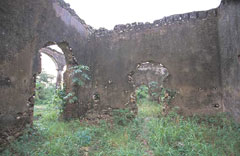 This Cuban National Monument is less than five kilometres from the road that leads to the town of Artemisa, 60 kilometres west of the capital, to the neighbourhood of Cayajabos. These ruins that are a quaint reminder of the period of slavery, rise up out of the environment dominated by dense foliage.
The legend surrounding a love story that took place here in the year of 1822 is the main theme of a movie called “Fragrant Oak “(Roble de Olor). Among the ruins that are a challenge to the passing of the years, the monument of the goddess Artemisa can be found. The visitor also may taste delicious dishes of native and international food in a charming restaurant, the building of which blends in with the natural beauty of the environment.
This Cuban National Monument is less than five kilometres from the road that leads to the town of Artemisa, 60 kilometres west of the capital, to the neighbourhood of Cayajabos. These ruins that are a quaint reminder of the period of slavery, rise up out of the environment dominated by dense foliage.
The legend surrounding a love story that took place here in the year of 1822 is the main theme of a movie called “Fragrant Oak “(Roble de Olor). Among the ruins that are a challenge to the passing of the years, the monument of the goddess Artemisa can be found. The visitor also may taste delicious dishes of native and international food in a charming restaurant, the building of which blends in with the natural beauty of the environment.
For more information:
www.cuba-lahabana.com
|
|
|
SAN ANTONIO DE LOS BAÑOS
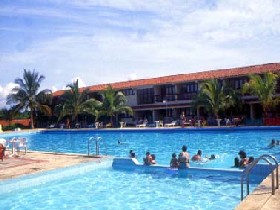 This region is home to the International Humour Festival (Bienal Internacional del Humor), exhibiting pieces from the first known caricature of the country to the modern works of today.
This is the seat of the International Cinema School (Escuela Internacional de Cine), an institution visited by many outstanding personalities such as the Nobel Prize Gabriel García Márquez.
It is the main city of the municipality, where there is a harmonious combination of buildings erected in the last three centuries, together with other modern styles.
The well-named Humour Villa (Villa del Humor) has rich cultural and sports roots. Also available is the Las Yagrumas Motel, a facility that is equipped with all kinds of comforts for making the travellers stay as agreeable as possible.
This region is home to the International Humour Festival (Bienal Internacional del Humor), exhibiting pieces from the first known caricature of the country to the modern works of today.
This is the seat of the International Cinema School (Escuela Internacional de Cine), an institution visited by many outstanding personalities such as the Nobel Prize Gabriel García Márquez.
It is the main city of the municipality, where there is a harmonious combination of buildings erected in the last three centuries, together with other modern styles.
The well-named Humour Villa (Villa del Humor) has rich cultural and sports roots. Also available is the Las Yagrumas Motel, a facility that is equipped with all kinds of comforts for making the travellers stay as agreeable as possible.
For more information:
www.cuba-lahabana.com
|
|
 This is a fertile area that is eminently industrial and agricultural, well known for its red rust coloured earth. This town treasures a beautiful history, since in 1953 many young men accompanied Fidel Castro on the assault on the Moncada Garrison (Cuartel Moncada), in Santiago de Cuba. It is a good idea to visit the solemn mausoleum built in honour of the region’s sons, who gave their lives in the struggles for independence.
Also located in Artemisa are the ruins of the famous coffee plantation La Angerona, a National Monument due to its cultural and historic values.
This is a fertile area that is eminently industrial and agricultural, well known for its red rust coloured earth. This town treasures a beautiful history, since in 1953 many young men accompanied Fidel Castro on the assault on the Moncada Garrison (Cuartel Moncada), in Santiago de Cuba. It is a good idea to visit the solemn mausoleum built in honour of the region’s sons, who gave their lives in the struggles for independence.
Also located in Artemisa are the ruins of the famous coffee plantation La Angerona, a National Monument due to its cultural and historic values.
 The deeply rooted traditions of the town closest to the capital’s international airport José Martí, come alive during the last days of the year. Then the “charangueros”, divided into two bands, establish a friendly competition carrying out the most varied activities atop their carriages. The final show takes place in the old church plaza and starts very early from the headquarters of each band, where many town people meet in order to follow their favourite carriages from where they were built. The parade through the streets becomes a prelude of the “charangas” show, while fire works, laughter, screams and the strong conga music from each band are heard, announcing the beginning of a great night.
The deeply rooted traditions of the town closest to the capital’s international airport José Martí, come alive during the last days of the year. Then the “charangueros”, divided into two bands, establish a friendly competition carrying out the most varied activities atop their carriages. The final show takes place in the old church plaza and starts very early from the headquarters of each band, where many town people meet in order to follow their favourite carriages from where they were built. The parade through the streets becomes a prelude of the “charangas” show, while fire works, laughter, screams and the strong conga music from each band are heard, announcing the beginning of a great night. The home of one of the founders of the first Communist Party of Cuba, has been turned into a museum and is located in the municipality of Guanajay, in the westward section of the province of La Habana.
Carlos Baliño was born on February 13th of 1848, and together with José Martí, he created the Cuban Revolutionary Party.
The building, which has resisted the years, dates from the first half of the XIX century, and is located at number 1205 Luz Caballero St., between Agramonte Ave. and 21 de Octubre Ave. The house is made up of a vestibule, a large living room, a garden, a room with a balcony overlooking the street, which is reached by climbing up a wooden staircase in the shape of a seashell.
This historical building has been declared a National Monument.
The home of one of the founders of the first Communist Party of Cuba, has been turned into a museum and is located in the municipality of Guanajay, in the westward section of the province of La Habana.
Carlos Baliño was born on February 13th of 1848, and together with José Martí, he created the Cuban Revolutionary Party.
The building, which has resisted the years, dates from the first half of the XIX century, and is located at number 1205 Luz Caballero St., between Agramonte Ave. and 21 de Octubre Ave. The house is made up of a vestibule, a large living room, a garden, a room with a balcony overlooking the street, which is reached by climbing up a wooden staircase in the shape of a seashell.
This historical building has been declared a National Monument.
 The ruins of the colonial sugar mill of La Alejandría are found to the south of the province of La Habana, in the municipality of Güines, less than three kilometres by the road that leads to the beach of El Rosario.
The place was declared a National Monument on December 31st of 1981 and it includes the remains of the aqueduct, the machinery and the house of the ancient sugar mill of La Alejandría.
These constructions date from 1790 and are an exceptional part of the technological variants of the use of water as a source of energy in the country.
La Alejandría is part of the cultural identity of the town of Güines and has been a source of inspiration for poets, writers, poetry improvisers, historians and artists, among many others.
The ruins of the colonial sugar mill of La Alejandría are found to the south of the province of La Habana, in the municipality of Güines, less than three kilometres by the road that leads to the beach of El Rosario.
The place was declared a National Monument on December 31st of 1981 and it includes the remains of the aqueduct, the machinery and the house of the ancient sugar mill of La Alejandría.
These constructions date from 1790 and are an exceptional part of the technological variants of the use of water as a source of energy in the country.
La Alejandría is part of the cultural identity of the town of Güines and has been a source of inspiration for poets, writers, poetry improvisers, historians and artists, among many others.
 It originated as a province in 1975 with a surface area of 5 731 square kilometres and more than 700 000 inhabitants.
Among its main tourist attractions are the well-known Jaruco Stairs (Escaleras de Jaruco), located in the municipality of the same name, a unique landscape product of the same topography, where the existence of rocky outcroppings and caverns make it the ideal scenario for adventurous tourism.
Along the northern coastline and close to the Vía Blanca highway that leads into Matanzas, the traveller can access Santa Cruz del Norte, a settlement where the largest rum production plant in Latin America is located, in whose warehouses the world famous Havana Club is produced.
Nearby are several different camping grounds, among them are Jibacoa, Puerto Escondido and Peñón del Fraile, a tourist pole that attracts the attention of national and foreign visitors, due to its warm calm crystalline waters, with heights of up to 100 metres.
It originated as a province in 1975 with a surface area of 5 731 square kilometres and more than 700 000 inhabitants.
Among its main tourist attractions are the well-known Jaruco Stairs (Escaleras de Jaruco), located in the municipality of the same name, a unique landscape product of the same topography, where the existence of rocky outcroppings and caverns make it the ideal scenario for adventurous tourism.
Along the northern coastline and close to the Vía Blanca highway that leads into Matanzas, the traveller can access Santa Cruz del Norte, a settlement where the largest rum production plant in Latin America is located, in whose warehouses the world famous Havana Club is produced.
Nearby are several different camping grounds, among them are Jibacoa, Puerto Escondido and Peñón del Fraile, a tourist pole that attracts the attention of national and foreign visitors, due to its warm calm crystalline waters, with heights of up to 100 metres.
 This Cuban National Monument is less than five kilometres from the road that leads to the town of Artemisa, 60 kilometres west of the capital, to the neighbourhood of Cayajabos. These ruins that are a quaint reminder of the period of slavery, rise up out of the environment dominated by dense foliage.
The legend surrounding a love story that took place here in the year of 1822 is the main theme of a movie called “Fragrant Oak “(Roble de Olor). Among the ruins that are a challenge to the passing of the years, the monument of the goddess Artemisa can be found. The visitor also may taste delicious dishes of native and international food in a charming restaurant, the building of which blends in with the natural beauty of the environment.
This Cuban National Monument is less than five kilometres from the road that leads to the town of Artemisa, 60 kilometres west of the capital, to the neighbourhood of Cayajabos. These ruins that are a quaint reminder of the period of slavery, rise up out of the environment dominated by dense foliage.
The legend surrounding a love story that took place here in the year of 1822 is the main theme of a movie called “Fragrant Oak “(Roble de Olor). Among the ruins that are a challenge to the passing of the years, the monument of the goddess Artemisa can be found. The visitor also may taste delicious dishes of native and international food in a charming restaurant, the building of which blends in with the natural beauty of the environment.
 This region is home to the International Humour Festival (Bienal Internacional del Humor), exhibiting pieces from the first known caricature of the country to the modern works of today.
This is the seat of the International Cinema School (Escuela Internacional de Cine), an institution visited by many outstanding personalities such as the Nobel Prize Gabriel García Márquez.
It is the main city of the municipality, where there is a harmonious combination of buildings erected in the last three centuries, together with other modern styles.
The well-named Humour Villa (Villa del Humor) has rich cultural and sports roots. Also available is the Las Yagrumas Motel, a facility that is equipped with all kinds of comforts for making the travellers stay as agreeable as possible.
This region is home to the International Humour Festival (Bienal Internacional del Humor), exhibiting pieces from the first known caricature of the country to the modern works of today.
This is the seat of the International Cinema School (Escuela Internacional de Cine), an institution visited by many outstanding personalities such as the Nobel Prize Gabriel García Márquez.
It is the main city of the municipality, where there is a harmonious combination of buildings erected in the last three centuries, together with other modern styles.
The well-named Humour Villa (Villa del Humor) has rich cultural and sports roots. Also available is the Las Yagrumas Motel, a facility that is equipped with all kinds of comforts for making the travellers stay as agreeable as possible.